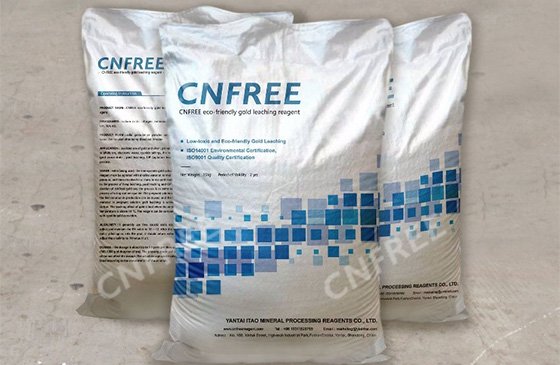2019-03-29 Views:5157
Warm Tip: If you want to know more information, like quotation, products, solutions, etc., please Click here ,and contact us online.

Sodium cyanide substitutes refer to the agent which is non-cyanide and can extract gold without changing its original cyanidation gold extraction machines and process.
As we all know, the cyanide gold extraction process is still the main gold extraction process used in most countries. In other words, most of the world’s gold today is made from cyanide. But as a cyanide is more and more widely used in mines, some problems must be taken into consideration.
Therefore, it is of great significance to carry out the research on sodium cyanide substitutes both in the ecological field and the economic field, which is also a big problem faced by the development of gold extraction industry in the world.
Chlorination was the first alternative method for searching the sodium cyanide substitutes. In 1984, aqueous chlorination and ammonia leaching were used to extract gold and silver from a gold mine. Gold and silver of good quality were successfully obtained, and copper and lead in the gold mud were successfully recovered. However, the limitations of this gold extraction method are very large, and the volatilization of chlorine gas will cause great harm to the environment. Therefore, although the chlorinated liquid leaching agent has been studied in recent years, the research results are not ideal, nor does it have the feasibility of large-scale promotion. So the struggle for sodium cyanide substitutes still continues.
Brominated gold extraction is also a promising gold extraction process that has been widely studied. Gold bromide extraction, that is, the use of bromide as sodium cyanide substitutes to extract gold in a process. According to the current information, bromide extracting gold with bromide as sodium cyanide substitutes has the advantages of cheap price, high leaching rate (90%-95%), fast leaching speed, non-corrosive, non-toxic at low concentration, convenient operation, and recycling. The United States grete lake chemical company used the bromide as sodium cyanide substitutes to test the gold ore sample. The grade of the gold ore sample before leaching was 219 — 379.2g/t, and the gold grade after baking reached 269 — 489.6g/t. Bromide leaching with br-based liquid (Geobrom3400) as sodium cyanide substitutes resulted in a gold solution with a recovery rate of 94 — 96% and gold content of 50mg/L. However, the development level of bromination gold extraction technology is still very limited, and the technology is not mature enough to be sodium cyanide substitute.
In addition, some compounds have also been used as sodium cyanide substitutes, including Haber agents developed by the American n.h. aber, biological agents studied by the Soviet union, malononitrile and iodide, polysulfide and thiocyanate, thiourea and thiosulfate reported in China and South Africa. Using thiourea and thiosulfates as sodium cyanide substitutes has also aroused a great interest in the research of sodium cyanide substitutes, but they have not been industrialized due to their narrow operating range and high drug consumption.
Over the years, scholars at home and abroad have carried out a lot of experimental research work, trying to find non-cyanide, non-toxic or low-toxic gold dressing reagents as sodium cyanide substitutes, some have made breakthroughs and applied for a national patent, which can even completely replace cyanide. As a sodium cyanide substitute, CNFREE is an environmentally friendly gold leaching reagent that can replace sodium cyanide without changing the original equipment and cyaniding process. It can be directly used for gold ore dressing and refining. Compared with traditional leaching agents, CNFREE can truly achieve the purpose of green environmental protection and effectively avoid serious accidents.
When used, CNFREE sodium cyanide substitute gold extraction reagent must be stirred with normal temperature alkaline water and then dissolved in the slurry for gold leaching. In the CIP production process of oxidized gold ore, heap leaching and pool leaching, CNFREE sodium cyanide substitute is used in the same manner as sodium cyanide. The most preferred material for leaching gold ore using CNFREE sodium cyanide substitute is activated carbon. When the ambient temperature is higher than 10 ° C, gold ore has the best leaching effect. This sodium cyanide substitute is compatible with sodium cyanide.
In order to study the difference between the leaching effect of sodium cyanide and the CNFREE sodium cyanide substitute leaching agent on gold ore, several gold ore samples were selected, namely the oxidized gold ore in kush, Sudan, the oxidized gold ore in Tanzania, the oxidized ore and gold mixed ore in Tanzania, and the oxidized gold ore tailings in Tanzania. The leaching rate, recovery rate and cost of CNFREE sodium cyanide substitute were all the same with that of sodium cyanide. And some indicators, such as the dosage and cost of drugs, CNFREE sodium cyanide substitute performance is better than sodium cyanide.
No matter in the applicability, leaching rate, leaching speed, price, recovery speed, cost and other economic aspects of consideration, or in low toxicity, environmental protection and other environmental considerations, the performance of CNFREE sodium cyanide substitute is better than sodium cyanide. Therefore, from all aspects, CNFREE is the best alternative to cyanide in the current environment.
If you need to know more about the CNFREE gold dressing reagent for your project, you can leave a message or consult online customer service, and experts will introduce for you.
 +8618890227893
+8618890227893
 pinklaurabao@gmail.com
pinklaurabao@gmail.com
 No. 188, Xinhai Street, high-tech Industrial Park, Fushan District, Yantai, Shandong, China.
No. 188, Xinhai Street, high-tech Industrial Park, Fushan District, Yantai, Shandong, China.

TOP